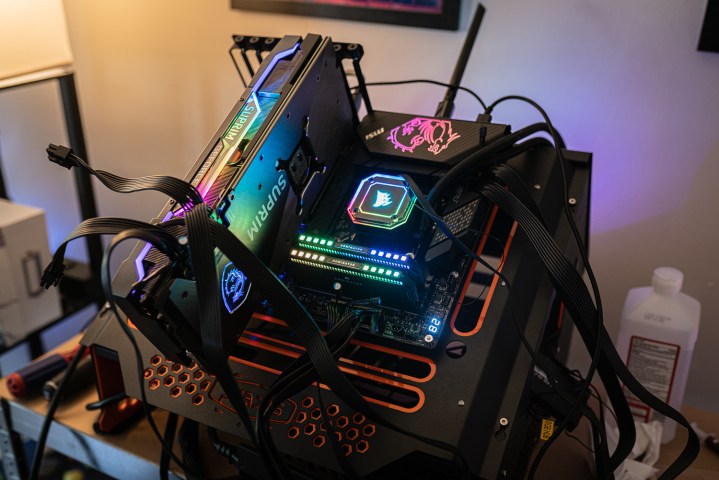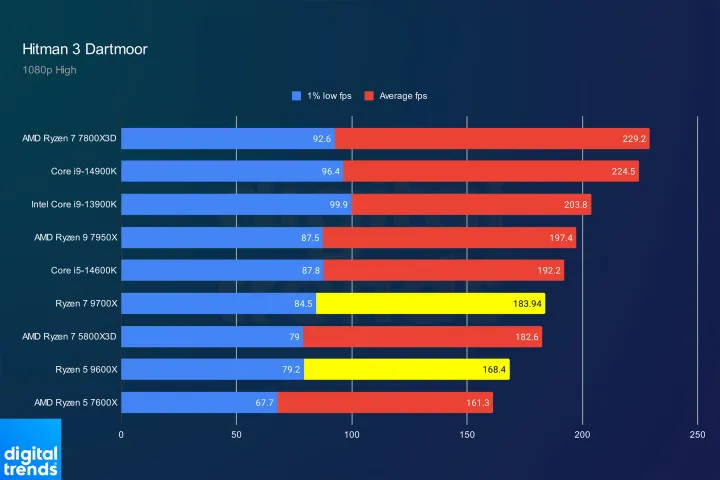AMD Ryzen 5 9600X and Ryzen 7 9700X review: an odd start to an exciting generation
AMD is finally introducing its Zen 5 architecture with the Ryzen 5 9600X and Ryzen 7 9700X, and the improvements are huge.


AMD Ryzen 5 9600X and Ryzen 7 9700X
MSRP $280.00
Pros
Massive uplift from AVX-512 Support for AM5 socket Cheaper than the previous generation Huge single-core performance improvementCons
Some lopsided performance results 3D V-Cache is waiting in the wingsCPUs are in a weird spot, and it’s hard to ignore that fact. AMD pulled an unprecedented move by delaying the launch of these new Zen 5 chips, and Intel’s widely reported instability issue still doesn’t have a solution. AMD’s new Ryzen 5 9600X and Ryzen 7 9700X are among the best processors you can buy right now, but they’re also entering the market at a time when good-faith comparisons are tough to make.
It doesn’t help that the Ryzen 5 9600X and Ryzen 7 9700X aren’t exactly easy CPUs to evaluate. They’re not built for gamers, with AMD’s 3D V-Cache CPUs dominating the list of the best gaming processors, and the performance improvements range anywhere from mind-blowing to middling. AMD’s latest chips are fast, there’s no doubt about that, and they easily earn a recommendation. Given how strange the CPU landscape between AMD and Intel is right now, however, it might be worth taking stock of where everything lands in a few weeks before picking up a new chip.
AMD Ryzen 5 9600X and Ryzen 7 9700X specs
 Jacob Roach / Digital Trends
Jacob Roach / Digital TrendsArchitecture is the name of the game for the Ryzen 5 9600X and Ryzen 7 9700X, and that’s immediately apparent when looking at the specs. Very little has changed compared to the last-gen Ryzen 7000 chips, with these parts boasting the same core counts, similar clock speeds, and identical cache. The improvements are all under the hood with the new Zen 5 architecture.
There are a lot of nerdy architectural details here for Zen 5 compared to Zen 4 — there’s an 8-wide dispatch unit now, up from 6-wide in Zen 4, as well as six Arithmetic Logic Units (ALUs), up from four previously. It’s the high-level objectives of the architecture that make a difference, though. AMD had a clear focus on single-threaded performance, and it built a true 512-bit data path for AVX-512 instructions. This, according to AMD, is a new foundation for CPUs going forward.
| Ryzen 7 9700X | Ryzen 7 7700X | Ryzen 5 9600X | Ryzen 5 7600X | |
| Cores/Threads | 8/16 | 8/16 | 6/12 | 6/12 |
| L3/L2 Cache | 32MB / 8MB | 32MB / 8MB | 32MB / 6MB | 32MB / 6MB |
| Max turbo frequency | 5.5GHz | 5.4GHz | 5.4GHz | 5.3GHz |
| TDP | 65W | 105W | 65W | 65W |
| Recommended price | $360 | $400 | $280 | $300 |
As I dig into my performance results, you’ll see that AMD achieved its design goals. This is a new foundation, however, and not the final form of where AMD will end up in a couple of generations. Performance overall feels lopsided, with some workloads showing middling performance and others showing earth-shattering gains.
Outside of architecture, there’s one important spec change particularly for the Ryzen 7 9700X. The last-gen Ryzen 7 7700X had a power draw of 105 watts, but AMD shrunk that to 65W this time around. That power is a little optimistic, with the chip commonly registering over 65W, but it’s still nice to see AMD push toward the efficient end of the spectrum for Zen 5. We saw how big of a difference that could make with the Ryzen 5 7600 (non-X) in the previous generation.
Test configurations
 Jacob Roach / Digital Trends
Jacob Roach / Digital TrendsAs with all of our CPU reviews, I put together two test configurations that were as close as possible. I used a high-end motherboard for both AMD and Intel tests, as well as a 360mm all-in-one (AIO) liquid cooler, 32GB of DDR5-6000 memory, a 1200W PSU, and an RTX 4080 Founder’s Edition graphics card. All BIOS settings were returned to their default settings, though I ensured XMP/EXPO and Resizable BAR were enabled for both platforms.
| AMD | Intel | |
| GPU | Nvidia RTX 4080 Founders Edition | Nvidia RTX 4080 Founders Edition |
| RAM | 32GB Gigabyte Aorus DDR5-6000 | 32GB Corsair Vengeance DDR5-6000 |
| Motherboard | Gigabyte X670E Aorus Master | MSI MPG Z790 MAG Tomahawk |
| CPU cooler | Corsair H150i Elite Capellix | Corsair H150i Elite Capellix |
| Power supply | Gigabyte Aorus P1200W | MSI MPG A850GF |
| Storage | Corsair MP400 1TB | MSI M450 1TB |
There’s a lot of talk about BIOS settings right now, with Intel’s CPUs featuring a major wave of instability due to improper BIOS adjustments. At the time of this review, those issues are still a work-in-progress. Performance may change once Intel’s CPUs are brought into a more stable spot. The goal with the performance here is to show what you should expect to see out of the box with any of the CPUs we feature.
Productivity performance
There’s no better place to start a CPU review than Cinebench R23, which immediately shows AMD’s improvements in action. Short of the Core i9-13900K and Core i9-14900K, AMD’s new chips are topping the single-core charts, and not by an insignificant margin. It’s a massive jump, and one that’s all the more impressive considering these are the weakest two of AMD’s current Zen 5 lineup. Keep in mind that the Core i9-14900K is rated to boost to 6GHz — the Ryzen 7 9700X is getting most of the way there at 5.5GHz.
Multi-core performance is, unsurprisingly, not as impressive. Intel’s mix of cores allows it to achieve much higher core counts, which show up more aggressively in a test like Cinebench. Still, we can clearly see some improvements. The Ryzen 5 9600X, for example, is able to match the Core i5-12600K with four fewer cores. That’s a sign of what the architecture is doing within the cores.
 Jacob Roach / Digital Trends
Jacob Roach / Digital TrendsPutting that multi-core performance into context, take a look at Handbrake. The Ryzen 5 9600X with six cores can now match the 16-core Ryzen 9 5950X from two generations back, and the Ryzen 7 9700X is at the heels of the Core i5-14600K despite its massive core deficit.
 Jacob Roach / Digital Trends
Jacob Roach / Digital TrendsPerformance in Photoshop is even more impressive. AMD already performed well in Photoshop, but it’s managing to outpace itself here. The Ryzen 7 9700X matches the Ryzen 9 7950X from last generation, and the Ryzen 5 9600X isn’t far behind. Photoshop isn’t the most demanding workload, but it’s still a clear showcase that the performance improvements are here.
These CPUs are doing exactly what they should, but there are also some lopsided numbers — for better and worse. You can see the worse in action in Blender and 7-Zip. The Ryzen 5 9600X and Ryzen 7 9700X are barely moving the needle in these tests, and in the case of 7-Zip, the Ryzen 5 9600X was actually a bit slower than the last-gen Ryzen 5 7600X (though not by enough for it to make a difference).
The better half is a lot better — so much so that I really didn’t believe the numbers at first. In the browser benchmark JetStream 2, the Ryzen 5 9600X and Ryzen 7 9700X provided the best results I’ve ever recorded. And in Y-Cruncher, calculating 500 million digits of pi, the single-core performance of these two chips absolutely destroys everything else on the market — and that includes the latest flagships. These are both fairly specific tests, but they show AMD’s Zen 5 improvements in the best light.
In tasks like photo editing in Photoshop or transcoding in Handbrake, these two CPUs are fantastic. Depending on what you’re doing, however, you may not see all of the performance gains. It’s clear that Zen 5 is a new foundation for AMD, and I suspect it will balance the scales of performance in some of the more specific workloads as time goes on.
Gaming performance
It’s difficult to talk about gaming performance with the Ryzen 5 9600X and Ryzen 7 9700X. The performance is decent to disappointing, but it doesn’t matter much anyway. AMD has already proven time and again that its 3D V-Cache tech is the key to the highest frame rates, and these chips don’t come with the extra cache. If you’re concerned with gaming, you shouldn’t buy the Ryzen 5 9600X or Ryzen 7 9700X — you should wait until 3D V-Cache versions of these chips come out.
 Jacob Roach / Digital Trends
Jacob Roach / Digital TrendsIf you take a 10,000-foot view of these chips, AMD is providing better performance in games. You can see that in the CPU score of 3DMark Time Spy. The Ryzen 7 9700X manages to outpace the Ryzen 7 7800X3D, while the Ryzen 5 9600X provides a disappointing but understandable uplift of 5% over the previous generation. As usual, real games tell a slightly different story.
 Jacob Roach / Digital Trends
Jacob Roach / Digital TrendsTake Hitman 3 as an example. AMD was able to outpace the Ryzen 7 5800X3D with the Ryzen 7 9700X, but both of these chips are a far cry from what the Ryzen 7 7800X3D can offer right now. Frankly, it’s not even in the same conversation.
 Jacob Roach / Digital Trends
Jacob Roach / Digital TrendsSimilarly, in Far Cry 6, AMD is not only offer a solid generational uplift, the Ryzen 5 9600X even managed to beat last-gen’s 16-core Ryzen 9 7950X. That’s impressive, at least until you realize how much faster the Ryzen 7 7800X3D is once again.
If you ignore the 3D V-Cache parts, AMD’s new Zen 5 chips are great. The problem is that PC gamers really can’t afford to ignore 3D V-Cache. I wouldn’t want to be caught with a Ryzen 7 9700X knowing that a Ryzen 7 9700X3D could launch in a matter of months. AMD has already confirmed they’re coming, and even the Ryzen 7 7800X3D continues to dominate gaming charts.
 Jacob Roach / Digital Trends
Jacob Roach / Digital TrendsSome of the lopsided performance I saw with productivity benchmarks showed up here, too. Take Red Dead Redemption 2 as a prime example. This game is in my CPU test suite to ground some of the conversation around gaming CPUs. It’s a graphically-intensive game, taking some of the focus off the processor. Oddly, AMD was able to break through this wall of performance that every other CPU I’ve tested has run up against, including the Ryzen 7 7800X3D. From my view, that says more about what we could see with 3D V-Cache versions of these CPUs and less about these two particular chips, however.
 Jacob Roach / Digital Trends
Jacob Roach / Digital TrendsFinally, there’s LeelaChessZero, and the chart really speaks for itself here. If there was any doubt that a dedicated 512-bit data path for AVX-512 instructions didn’t matter, this chart puts that to rest. It’s a massive improvement, and I can’t wait to see how the more powerful Ryzen 9 9900X and Ryzen 9 9950X fair in this benchmark.
Should you buy the Ryzen 5 9600X and Ryzen 7 9700X?
 Jacob Roach / Digital Trends
Jacob Roach / Digital TrendsComing in at $280 for the Ryzen 5 9600X and $360 for the Ryzen 7 9700X, these are two compelling CPUs. AMD is offering a generational uplift, and it’s coming in at a lower price. That pricing cut wasn’t made out of goodwill, though. There are still some oddities with these chips and the strange results they can produce, leading to unbelievable performance increases in some workloads and barely any improvement in others.
If you already have a Zen 4 CPU, there isn’t enough meat on the bone to justify an upgrade here. That may change once we see the flagships in action, but lower down the stack, the changes aren’t as drastic. The only exception are workloads like AVX-512, where the new Zen 5 architecture absolutely crushes everything else.
Gamers don’t need to worry, either — the Ryzen 7 5800X3D is still putting up impressive results years after its release, and the Ryzen 7 7800X3D remains the undisputed champ of gaming performance. Zen 5 brings gaming improvements, there’s no doubt about that. But the 3D V-Cache versions of these chips will let those improvements sing.
The Ryzen 5 9600X and Ryzen 7 9700X are great if you haven’t upgraded to the AM5 platform yet, however. They’re faster and cheaper than Ryzen 7000 options, and even moreso now considering the drop in DDR5 memory prices. If you’ve already taken the plunge to AM5, however, you can probably take this generation off — AMD says we’ll be getting more generations on this socket, after all.

 JaneWalter
JaneWalter 







































